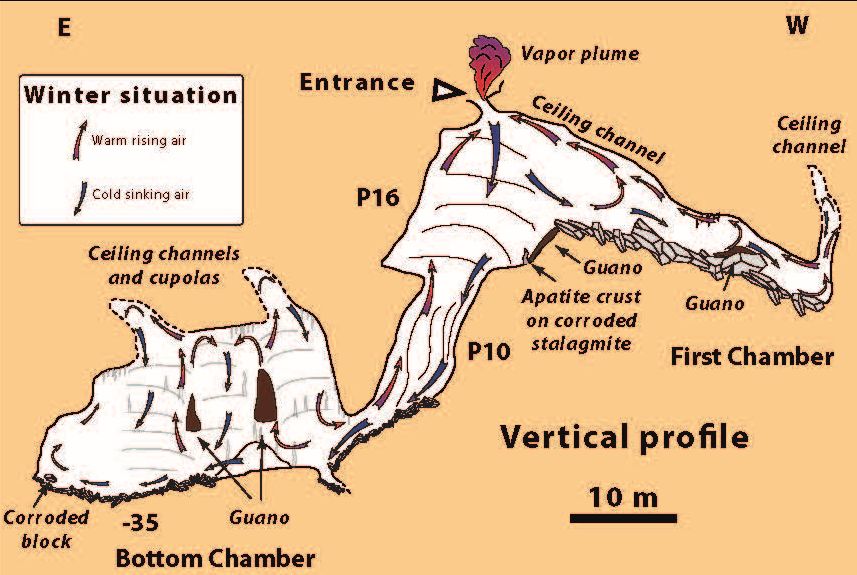The contribution of condensation-corrosion in the morphological evolution of caves in semi-arid regions: preliminary investigations in the Kyrenia Range, Cyprus
DOI:
https://doi.org/10.3986/ac.v48i1.6782Keywords:
East-Mediterranean condensation-corrosion, guano, Kyrenia Range-Cyprus, open-fracture-caves, fast tectonic uplift, gypsum, cave microclimatology, Pleistocene.Abstract
The condensation-corrosion process occurs when airflow cools at the contact with colder cave walls. Condensed water becomes aggressive for soluble rocks and corrodes the walls. This process is particularly active close to cave entrances in high thermal gradient zones where external air enters caves. Condensation appears to be important where bat colonies are also present. Bat metabolism and guano decomposition release heat, vapour, and acids. Hence, bat colonies contribute to the increase of condensation- corrosion, especially by providing permanent moisture and chemical aggressiveness. Corrosive air convections produce rounded morphologies, such as ceiling channels, cupolas, and corroded older flowstones. This process has been overlooked in previous research, since related morphologies were often confused with those produced by early phreatic flow. Kyrenia Range in Cyprus has a semi-arid climate. All the studied caves developed along open-fractures. They are located both in recrystallized carbonates (limestone and dolostone, such as Smoky and Pigeons Caves), or in gypsum (First Day and Angry Bat Caves). We also studied a maze cave that acted as a spring in gypsum that initially developed under phreatic conditions, followed by an epiphreatic phase that allowed the development of notches (Fig Tree Cave, also named İncirli Show Cave). Due to the semi-arid climate, external air is very dry in summer, thus condensation seems to occur mainly in winter, when cave atmosphere instability allows large air exchanges between caves and surface atmosphere. In summer, evaporation prevails, allowing the development of popcorn lines in carbonate caves and massive gypsum crusts, stalagmites, and sidewalk rims in gypsum caves. However, the presence of a bat colony in a semi-confined chamber in Smoky Cave is probably the origin of the permanent moisture, also during the dry season, leading to a strong development of condensation-corrosion features such as ceiling cupolas, and possibly to the permanent activity of flowstones. In addition, we detected high concentrations of sulphur dioxide (SO2) and radon (Rn) in Fig Tree Cave, possibly related to the activity of the neighbouring overthrust. Based on the five studied caves in the Kyrenia Range and surroundings, the open-fracture caves in carbonates and gypsum have not undergone the typical initial phreatic stage, but have formed in a short time during Pleistocene as a result of the fast uplift of the range and were later reshaped by condensation-corrosion morphologies. Some gypsum caves may have formed entirely by this latter process, after initial minor fracture development. Cyprus is an outstanding area for studying the condensation-corrosion in caves, since a phreatic origin can be ruled out for most of the rounded morphologies.
Prispevek kondenzacijske korozije pri razvoju jam v polsuhih območjih: predhodni rezultati v jamah Kirenijskega gorovja, Ciper
Kondenzacijska korozija se pojavi ob stiku vlažnega zračnega toka s hladnimi jamskimi stenami. Pri tem na jamsko steno iz zraka kondenzira film vode, ki kemično korodira vodotopno kamnino. Proces je najbolj izrazit v bližini jamskih vhodov, kjer ob visokem temperaturnem gradientu zunanji zrak vstopa v jamo. Kondenzacijo in kondenzacijsko korozijo lahko pomembno povečajo kolonije netopirjev. Metabolizem netopirjev in razpadanje gvana sproščata toploto, vlago in kisline. Kondenzacijska korozija iz konvekcijskih tokov vlažnega zraka ustvarja zaobljene skalne oblike, kot so kupole, stropni kanali in korodirana siga. Kirenijsko gorovje na Cipru ima polsuho podnebje. Večina jam v tej raziskavi so odprte razpoke v prekristaljenem karbonatu (apnenec in dolomit) ali v sadri. Poleg teh obravnavamo tudi blodnjake v sadri, ki so se oblikovali v freatični coni in so v preteklosti delovali kot izviri. V njih najdemo stenske zajede, ki so nastale v epifreatični fazi. Ker je zrak poleti zelo suh, je kondenzacija omejena na zimski čas, ko se intenzivno izmenjuje zrak med jamsko in zunanjo atmosfero. Poleti prevladuje izhlapevanje, kar omogoča razvoj cvetačastih oblik v karbonatnih jamah ter sadrinih skorij, stalagmitov in stranskih obrob v jamah v sadri. Kolonija netopirjev v eni od polzaprtih dvoran v jami Smoky Cave verjetno vzdržuje visoko vlago tudi poleti. Posledica so močno izražene oblike kondenzacijske korozije (kupole) in stalna aktivna rast sige. V eni od jam smo izmerili visoko vsebnost SO2 in radona, ki je verjetno povezana z aktivno narivno tektoniko. Pet obravnavanih jam je tektonskega izvora in so verjetno nastale v kratkem obdobju hitrega dvigovanja v pleistocenu ter bile kasneje preoblikovane s kondenzacijsko korozijo. Nekatere jame v sadri so nastale skoraj izključno s kondenzacijsko korozijo, ki je preoblikovala prvotne majhne razpoke. Ciper je izjemno območje za podobne študije, saj lahko zaradi odsotnosti freatične faze večino zaobljenih jamskih oblik pripišemo kondenzacijski koroziji.
Ključne besede: Vzhodno Sredozemlje, kondenzacijska korozija, gvano, Kirenijsko gorovje, jame v odprtih razpokah, hitri tektonski dvig, sadra, jamska mikroklima, pleistocen.
Downloads

Downloads
Published
How to Cite
Issue
Section
License
Authors guarantee that the work is their own original creation and does not infringe any statutory or common-law copyright or any proprietary right of any third party. In case of claims by third parties, authors commit their self to defend the interests of the publisher, and shall cover any potential costs.
More in: Submission chapter




